In a scenic lagoon on Nicaragua’s Brito River, less than a mile from the Pacific Ocean, schoolteacher Jorge Lopez and a friend were fishing on a recent morning. He gestured toward a bend in the narrow river, canopied with arching trees draped in moss, and said, “There are howler monkeys, crocodiles, and parrots all along this waterway. It would be a shame to lose all this.”
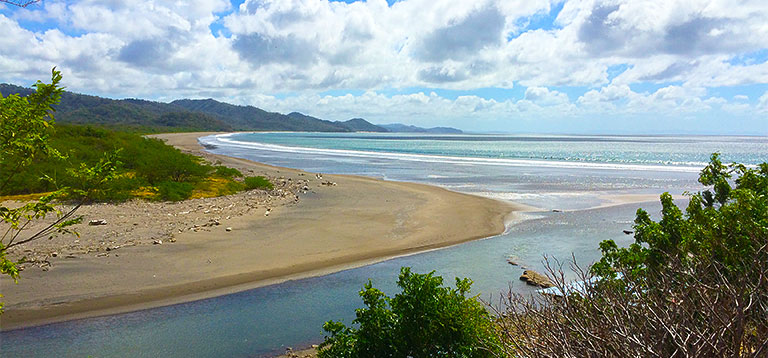
The mouth of the Brito River where it empties into the Pacific Ocean, the proposed western terminus of the Nicaragua Grand Canal.
What threatens this tranquil spot and many others in Nicaragua is a controversial and wildly ambitious project to build a 173-mile canal — more than three times the length of the Panama Canal — that would connect the Pacific and Atlantic oceans via the Caribbean Sea. The $50 billion canal project is the brainchild of Chinese businessman Wang Jing and has the full support of the Nicaraguan government, which claims that the canal will give a huge boost to the country’s economy, the second poorest in the Western Hemisphere after Haiti.
Many Nicaraguans back the canal project, and preliminary work has already begun — even before the completion of an environmental impact assessment. But other Nicaraguans, as well as local and international scientists, say the canal would be an environmental catastrophe, threatening a host of ecosystems across the country. They say it would also displace tens of thousands of Nicaraguans, including indigenous people whose territories the canal would cross.
The impacts would begin near Lopez’s fishing spot, where a breakwater and giant port — capable of docking supertankers and immense cargo ships carrying 25,000 containers — are planned as the western terminus of the canal. The port infrastructure along Nicaragua’s Pacific coast would threaten mangrove swamps and sea turtle nesting beaches. Then, passing through the remote, hilly coastal region where Lopez fished, the canal, carved to a depth of nearly 100 feet, would continue 16 miles through
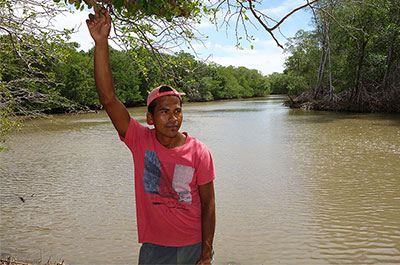
Jorge Lopez, shown on the banks of the Brito River, opposes the Nicaragua canal project. CHRIS KRAUL
Scientists say the damage to Lake Nicaragua could be enormous. One third of the canal’s total length would traverse the lake, whose average bottom of 40 feet would have to be dredged to nearly twice that depth. The digging in the lake and over the rest of the canal’s proposed route would generate an almost unfathomable quantity of mud and dredging spoils — enough to cover the entire state of Connecticut with one foot of dirt. Silt would cloud the lake’s water column, threatening indigenous fish and other species, scientists warn, and invasive species could make their way into the lake along the canal from the Pacific and the Caribbean.
From Lake Nicaragua, the canal would head east, slicing through remote wetlands, nature reserves, and forests, many of them now inaccessible by road. The canal and related infrastructure could easily be several miles wide, and roads and construction camps would open up large areas of wilderness inhabited by indigenous people, thousands of whom would have to relocate.
On the Caribbean side, the traffic generated by supertankers and cargo ships could threaten sensitive marine ecosystems, including a 250-square-mile Colombian biosphere reserve that includes the second-largest coral reef system in the Caribbean. And the canal would cut in two the so-called Mesoamerican Biological Corridor, a loose network of reserves and other lands that stretches from southern Mexico to Panama and is used by animal species such as jaguars to traverse Central America.
The canal proposal was pushed by President Daniel Ortega and sailed through the National Assembly with scant debate and no bidding.“In our view, this canal would create an environmental disaster in Nicaragua and beyond,” Jorge Huete-Pérez, a biology professor and foreign secretary of the Nicaraguan Academy of Sciences, wrote earlier this year in a joint commentary with a German colleague in Nature. “The excavation of hundreds of kilometers from coast-to-coast will destroy around 400,000 hectares of rainforests and wetlands. The accompanying development could imperil surrounding ecosystems.”
The scale of the canal is so grand, the price tag so high, the economics so uncertain, the background of Wang Jing so murky, and the potential environmental damage so extensive that many question whether the canal will ever be built. Some skeptics think that rather than building the canal, Wang Jing has set his sights on building nine “sub-projects” that the Nicaraguan government has given him the exclusive right to develop in and around the canal zone. These projects include a major airport near the city of Rivas and a nearby free-trade zone that will resemble the one in Colon, Panama. Wang Jing also has the option of building major tourist resorts on four of nine sites that initially would be used for worker housing camps, including picturesque Ometepe Island in Lake Nicaragua.
Nevertheless, the canal project continues to move forward. Jing’s company, the Hong Kong Nicaragua Canal Development Group (HKND), in 2013 was granted a renewable 50-year concession to build and operate the canal. The proposal —
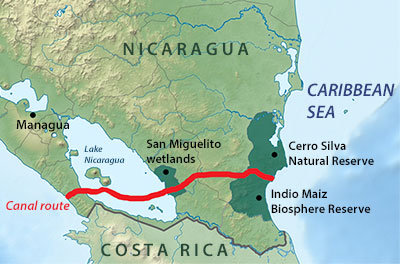
The route of the canal cuts through Nicaragua from the Pacific Ocean to the Caribbean Sea. YALE ENVIRONMENT 360
“It has more staying power than one might have expected,” said Thomas Lovejoy, a U.S. ecologist at George Mason University who has worked extensively in South America and who has been conferring with Nicaraguan scientists on the canal project. “The way it has been handled by the Nicaraguan government is the opposite of transparent. It’s as opaque as all those sediments that would be rendered in the lake. … It’s a great example of how bad ideas never go away.”
Victor Campos, director of the Humboldt Center, a leading Nicaraguan environmental think tank based in Managua, raised similar concerns about the lack of transparency and the absence of a comprehensive environmental impact assessment and economic feasibility studies. “We have only partial and incomplete information, even though the proposed canal route would bring incredible consequences,” Campos said.
Many observers also question whether the canal project makes economic sense, given that the Panama Canal is now undergoing a $5.25 billion expansion that would enable it to accommodate more large ships — a key target market of the Nicaraguan venture.
Among the many concerns of scientists and environmentalists is that HKND has commissioned its own environmental assessment, which they contend is being carried out in hurried fashion. Scientists say that the consulting firm doing the work, Environmental Resource Management (ERM), is a respected one, but it has been given little more than a year to carry out an environmental assessment that should take at least several years to complete. ERM’s report on the canal is due later this month.
“The whole thing is backwards. They’ve started construction. Yet there is still no environmental impact assessment.”At a meeting earlier this year with ERM in Miami, an international group of scientists pointedly questioned the firm’s representatives, saying they still lacked basic knowledge on key questions, such as the currents in Lake Nicaragua and the composition of the lake bottom.
“I have been an outspoken critic,” said meeting attendee Axel Meyer, an evolutionary biologist at the University of Konstanz in Germany and co-author of the Nature commentary with Huete-Pérez. “The whole thing is backwards. They’ve settled on a route. They’ve started construction. Yet there is still no environmental impact assessment.”
Yale Environment 360 contacted HKND for comment for this article, but received no response.
The greatest environmental concerns center on the canal’s impact on Lake Nicaragua, which contains 40 endemic fish species, including a rare freshwater shark and 16 kinds of cichlids. The fate of the 3,170-square-mile lake was the main focus of a November meeting in Managua of 15 scientists, including representatives of several academies of science from around the Americas. Researchers were concerned that the lake dredging and the planned 25 daily crossings of huge ships would compromise the lake’s water quality, as could potential fuel spills. The lake currently provides drinking water for some
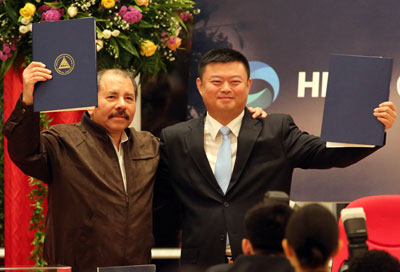
Wang Jing, president of the Chinese company HKND, won support from Nicaraguan President Daniel Ortega (left). GETTY IMAGES
Scientists at the Managua meeting raised questions about where the company will put the 5 billion cubic meters of dredged earth and lake bottom that that canal’s excavation work will create. In a December planning update, HKND said most of the earth will be transferred to 35 “confined disposal facilities” along the three-mile-wide shoulders on either side of the land portion of the canal. One mound of dredged earth would be located in Lake Nicaragua itself, creating an artificial island, HKND says.
But critics such as the Humboldt Center’s Campos wonder about the viability of the dredging plan if the spoils turn out to be toxic. “What could happen is that contaminants like mercury, arsenic, and heavy metals that lie beneath the lake bottom, which were put there by volcanic activity, will be brought to the surface by the digging. This could alter the natural composition of the water.”
Another major question is how much dredging will be necessary to keep the canal’s channel across Lake Nicaragua open. If soft sediment keeps moving back into the channel, then frequent dredging could “really wreak havoc with the food chain and the ability of species to survive,” said Lovejoy.
He and others also are concerned that the canal could open up a corridor for invasive species to travel from the Caribbean to the Pacific, or vice versa, and to bring alien species into Lake Nicaragua. The Panama Canal’s configuration and elevation have created a freshwater barrier that has largely eliminated the invasive species problem there. But researchers say it is unclear if the Nicaraguan canal would be as effective a barrier.
When the canal leaves the eastern side of Lake Nicaragua, it would pass through or near nature reserves and would likely cause major environmental and human upheaval in many remote regions of eastern Nicaragua, critics warn. The current canal route would follow the border between two adjoining nature preserves, Cerro Silva and Indio Maiz. These highly biodiverse reserves total 2,600 square miles and include swamps, rain forests, and pristine Caribbean coastal mangroves. They harbor cat species such as jaguars, ocelots, and mountain lions, as well as numerous species of birds, including the harpy eagle.
The canal would run alongside the San Miguelito wetlands, a biodiverse latticework of marshlands and rivers.A little-developed river in eastern Nicaragua, the Punta Gorda, would also become part of the canal. And roads would spring up throughout the region, which would likely lead to settlers, forest clearing, poaching of wildlife, and loss of biodiversity.
“You have to have access for construction,” said Meyer, who has worked in Nicaragua and other parts of Central America. “They have to have roads in some areas where there are no roads. How do you keep people from settling there? Of course roads are always the beginning. … It’s just like in the Amazon or Africa. As soon as you have roads, people will come.”
In addition, HKND is planning to create a 152-square-mile reservoir in eastern Nicaragua called Lake Atlanta, which would extend into both the Cerro Silva and Indio Maiz reserves. The lake would be used to store water to fill the locks planned for the canal’s Caribbean side. But scientists warn that the reservoir would siphon off water from the San Juan and Punta Gorda river basins. Reduced water flows and added sediment from dredging could affect the morphology of the rivers and especially be felt on the heavily transited San Juan, part of which runs along the border with Costa Rica. Should rainfall patterns change as the climate warms, there may be insufficient water to fill the canal and its locks and also meet Nicaragua’s water needs, scientists say.
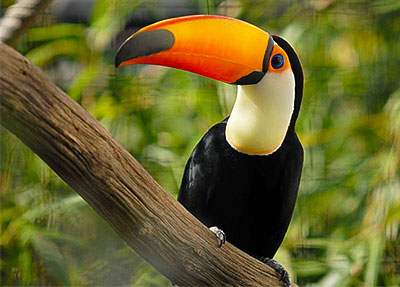
The canal would pass through sensitive wetlands and nature reserves, impacting wildlife such as toucans. WIKIMEDIA COMMONS
The canal’s impacts will almost certainly be felt beyond Nicaragua’s borders. Ninety miles off the coast of Nicaragua is the Seaflower Biosphere Reserve, a large marine reserve that boasts the Caribbean’s second-largest coral reef network.
Changes in water quality, transparency, and temperature could cause the Seaflower ecosystem to “collapse,” according to Francisco Arias Isaza, director of Invemar, an oceanographic research agency funded by the Colombian government. “A new canal of the magnitude they are talking about would funnel huge cargo ships to the area, and that worries us,” he said.
Scientists worry not only about what the project could do to the environment, but what the environment could do to the canal. Nicaragua is the scene of frequent seismic and volcanic activity and is in the pathway of Caribbean hurricanes, factors that persuaded the U.S. government to bypass Nicaragua and instead select Panama, which is off the hurricane track, as the site of the famous waterway built early last century.
“Nicaragua has experienced at least four Class 4 or greater hurricanes since 1855,” said Bob Stallard, a hydrology expert with the U.S. Geological Survey, who has studied the effect of storms on the Panama Canal for 30 years. “The cost of fixing damage [to the canal] could be as much as building the thing in the first place.”
The last major storm to hit Nicaragua’s Caribbean coast, Hurricane Mitch in 1998, killed 3,800 Nicaraguans and inflicted $1 billion in damage. The canal’s planned Caribbean port, Punta Gorda, suffered major damage.
For most Nicaraguans, environmental concerns about the canal run a distant second to the economic stimulus that President Daniel Ortega has promised the canal would deliver. He has described the project as a booster rocket that will launch Nicaragua toward economic prosperity.
Ernesto Salinas, a carpenter, lives in the small town of Tola near the canal’s Pacific terminus. His pueblo is in the path of the canal and would have to be relocated. He thinks that overall the canal is a good idea because it will bring “more jobs, less poverty” to his agricultural community, where plantains and beans are the money crops. “Bring it on,” he said. His main concern is when and how much the developer will reimburse him for the 500-acre farm his family owns along the canal route.
According to Telemaco Talavera, a spokesman for the Nicaragua Interoceanic Canal Authority, the waterway and related “sub-projects” will add 50 percent to the country’s economic base and boost the economy’s annual growth rate to twice the current 4 percent.
For most Nicaraguans, environmental concerns run a distant second to the promised economic stimulus that the canal would deliver.Benjamin Lanzas, head of a Managua engineering company and president of the Nicaraguan Chamber of Construction, said the project could deliver much-needed public infrastructure that would stimulate development across the country and have a “multiplier effect” on economic growth.
“We need better roads, better airports, better Internet, better tourist attractions, better everything,” said Lanzas. “For example, this project will include two deepwater ports which we don’t have, one on the Pacific and one on the Atlantic.”
Lanzas insisted the environmental damage caused by the construction will be “minimal.” But, he added, “If I have to run over a little frog for this project to go forward and create jobs, I will.”
Critics say the talk of an economic windfall is highly speculative, particularly in light of the fact that HKND has yet to make public an economic feasibility study.
“What I’m afraid of is that the government is placing commercial interests above the nation’s environmental well-being,” said scientist Huete-Pérez.
Monica Lopez Baltodano, an environmental attorney with the Popol Na civil society group that advocates for indigenous rights, claims that Wang Jing failed to consult with native communities in the path of the proposed canal — a violation of the Nicaraguan constitution. But canal backers say special laws passed by the National Assembly gave HKND the right to build
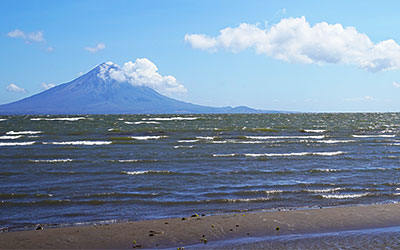
Lake Nicaragua would undergo major dredging to make the canal navigable for large ships. CANTERBURY/FLICKR
“By international standards, HKND hasn’t presented even 1 percent of the information to the public that it should, and there is uncertainty about whether it ever will,” Lopez Baltodano said in an interview. “We’re talking about the transfer of national territory to a private investor with very few limits on what he can do.”
ERM, the project’s consulting firm, said in an email that it has conducted 2,000 “household surveys” and has “consulted closely with indigenous communities.”
Yet Joe Kiesecker, a scientist with The Nature Conservancy, faulted the lack of an in-depth, independently funded environmental impact assessment (EIA). Such a study, he said, would enable the public to “see what the future looks like if a development goes forward and what you can do to minimize negative biodiversity, social, and cultural impacts.” The EIA for a project this size, which will have huge direct and indirect effects, should have been started a decade earlier, he said.
Asked why the canal’s planning has gone forward without the usual public hearings and studies in hand, canal authority president Manuel Coronel Kautz said it was due to stipulations agreed upon by the Nicaraguan government and Wang Jing.
“We discussed doing studies first — some in the National Assembly wanted that,” said Kautz. “But if we waited for the last letter of the studies to be completed it could mean up to four years of waiting. The other factor was cost. There was no way Wang Jing was going to invest $300 million in studies without the security of having the concession in hand. So we thought we would do a parallel process.”
With so many questions hanging over the canal, many observers wonder if it will ever become reality. Huete-Pérez remains one of the doubters, noting that when scientists asked HKND if it had studied Lake Nicaragua’s currents and the composition of its lake bottom, the company replied that such studies were unnecessary.
“That made me wonder,” recalls Huete-Pérez, “if this was a serious project.”
This article is a joint project between Yale Environment 360 and Chinadialogue, with support from the Pulitzer Center on Crisis Reporting. A Chinese-language version is available at Chinadialogue.